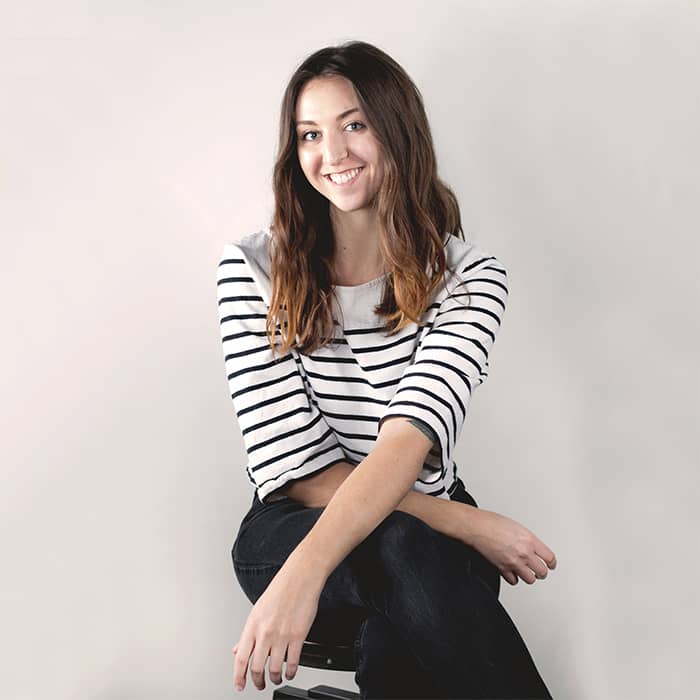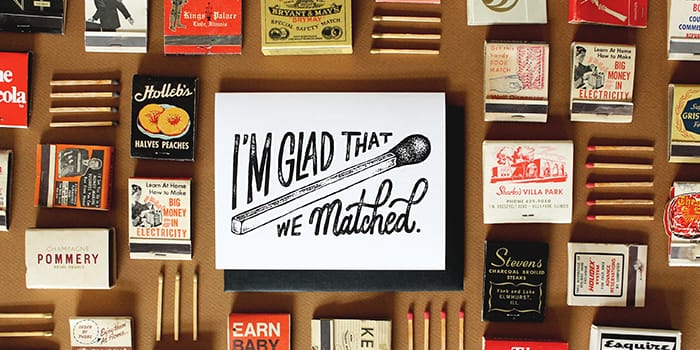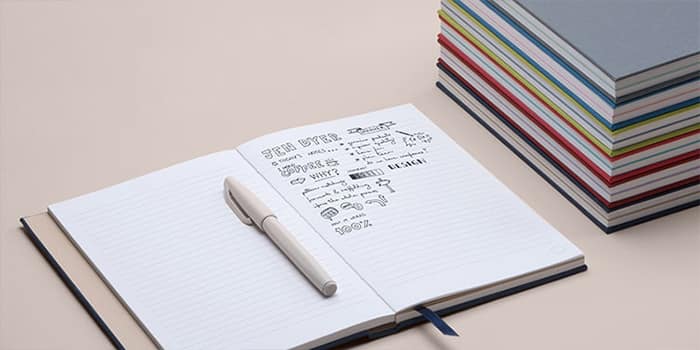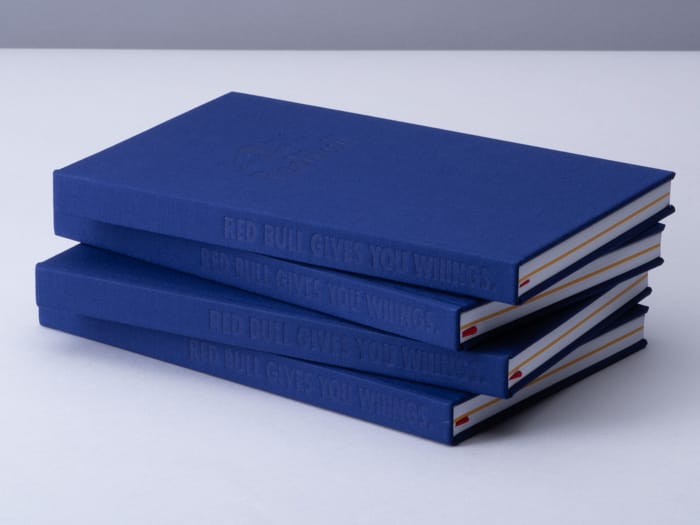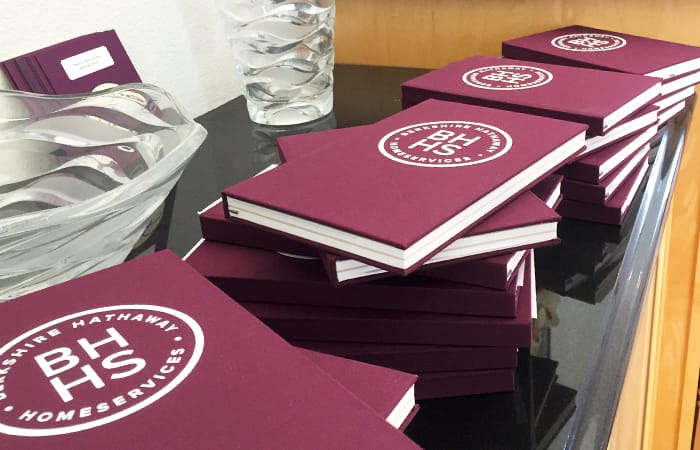Aidan Gooding Donoghue: the art of marrying music and design
We asked the London-based designer what it takes to succeed as a graphic designer in the music industry.
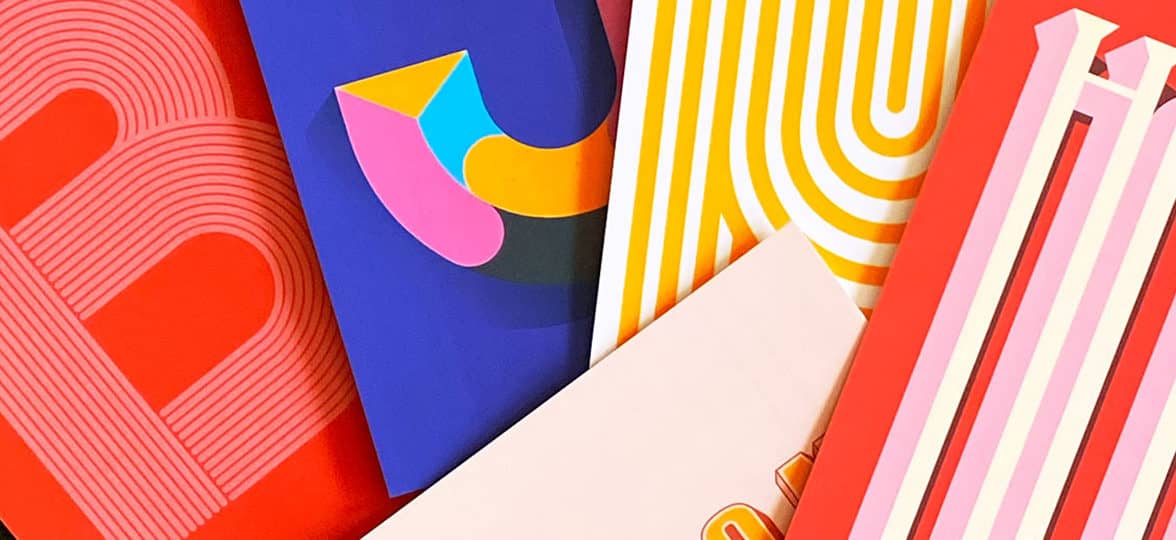
Graphic designer Aidan Gooding Donoghue (aka MadeYouLook) plays with typography and bright colors to create bold designs that tell a story. He masters the art of visual storytelling with striking compositions that caught the eye of the music industry – among others.
We met Aidan to talk about his work with typography, the evolution of his style and how he conveys the power of music through graphic design.
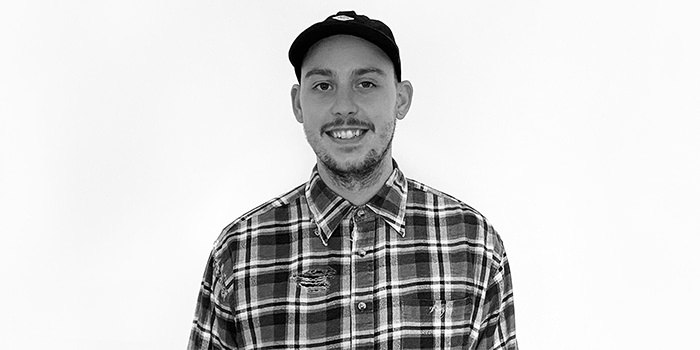
Tell us a bit more about yourself. How did your interest in graphic design begin?
I’ve always been interested in art and, as a child, I was always drawing and coloring. Art was my favorite subject at school and I used to bunk off my lessons to go and work on my latest projects. I used to do a lot of mixed media work and gradually found out more about screen printing and technical drawing which started to lead me down the graphic design route.
It actually took me quite a while to start doing digital work, as I’d never really had the opportunity to before. It was only my second year of university when I really started to learn about the softwares and became involved with design.
Your work has a very distinctive, bold style. How did it evolve over time?
I never initially had a bold or bright style to start with. My art was very grungy and predominantly quite dark. One day, I went to a job interview with my portfolio and they asked if I had anything more colorful – which I didn’t. This made me think “Why have I been so scared of using color?”. I started incorporating more and more color into my designs and now to the point where there’s barely any black within them!
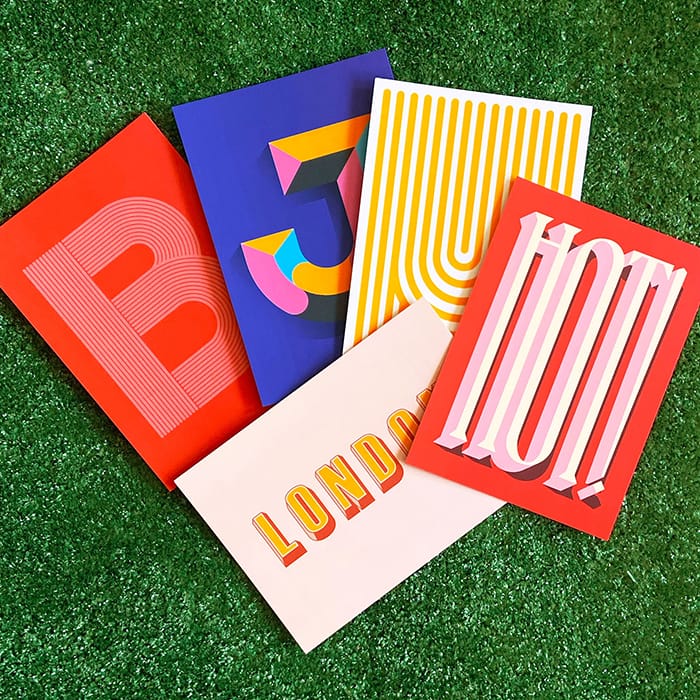
Music plays an intrinsic part in your portfolio. What led you towards designing band merchandise?
I’ve always been interested in music, but I’m absolutely hopeless at playing it. I always wanted to be part of the music scene and found that my design skills were something that I could offer bands.
Funnily enough, for my secondary school graphics course, I chose to create a fictional piece of design for a band that I liked as my main project. I created a piece of merchandise and a way to promote it along with a CD (when CDs were the predominant format to listen to music!). It also included a T-shirt, packaged along with the album in one box which could be sold at shows and online. I think this project gave me an idea of what I actually wanted to do, and I was lucky enough to end up working as a graphic designer in the music industry.
What was your first design for a music brand, and how did you land it?
I’ve always worked with friend’s bands and the local scene, but my first actual music design job was for Latitude festival when I started working for Firebrand Live on their merchandise and the event program which I was lucky enough to design the cover for. By continuing to work with Firebrand, I’ve been able to work and collaborate with a huge variety of bands and music festivals.
These projects gave me a great opportunity to work with clients I dreamed about working with. I believe that my passion for music and design has led me to this point and I think dedication can get you anywhere.
Want to design your own event program? Get started here.
What piece of advice would you give to design graduates hoping to break into the musical arena?
Keep persistent with designing. It doesn’t matter how much attention it gets just as long as you’re getting your work out there and getting seen.
Design for who you want to work for. Create your own briefs and work towards them, support your local bands and just do your best to get involved within the local scene. People will remember that and it can take you a long way.
How do you approach a merchandising brief from a band?
When a new brief comes in for a merchandise range, I have to take on board the artist’s ideas and do the best I can to work that into a design. However, a lot of the work is also about finding out what the fans want too. There’s always a lot of research which goes into who the fans are and the music that surrounds them. Unfortunately, what the fans want and what the artist wants isn’t always the same thing, so it can be difficult to merge the two together.
Another big part of the process is about how the design is used. Before anything is ever made, I create a vast amount of mockups to get an idea of how it will all look. It’s very easy to get wrapped up in creating artwork digitally, especially with short deadlines, but taking that extra time to experiment physically is essential as, at the end of the day, I’m designing for a physical product so it will never look like it does on screen.
Do you listen to music while you work, and is it an important part of the creative process for you?
I almost always listen to music when I’m working, especially when I’m working for a band. I try to listen to their music as well as similar artists to get myself in the right headspace. It gives me a better idea of what the bands are about. I also sometimes use their lyrics within the designs.
I find listening to music in general really focuses me onto a project. Album covers are also a great source of inspiration for creativity as they can really open your eyes to different styles and mediums.
Typography also features heavily in your work. What do you love about it, and why did you choose to focus on it?
I love the versatility of typography. You can convey the same message in so many different ways, it’s pretty limitless. I started working with typography as an easy way to practice a style of design or a new skill. I think that was because with a typeface, you already have something to work with. It’s a good starting point and you can even reinvent the initial purpose of the type by designing around it.
How have you used MOO products to help strengthen your brand?
Starting to look more into my own personal branding, MOO has been a great help with creating products that allow me to do that and reach new audiences with physical items that I feel people appreciate in a whole different way than when it’s on a digital screen.
I punched holes into my business cards to incorporate my logo design in a novel way. I like the idea of being able to create something with movement in a tangible way where the customer can interact with things differently, giving them a unique experience and hopefully making it memorable.
What is your favorite piece or collaboration to date?
Picking one piece is pretty tough! I think my favorite product has to be the Kaiser Chiefs skateboard I designed, because I’ve always wanted to do board graphics and think it came out pretty well. My favorite merchandise range would be the Creamfields range last year. I think it worked really well together and fitted the audience well. And my favorite collaboration would be the T-shirt designs I created for Arctic Monkeys, mainly because I’m a big fan of theirs and it was pretty cool getting to work with them!
Unfortunately, due to the pandemic, the music industry has taken a big hit, but I’ve got a few projects that I’m working on which are non merchandise-based, which is exciting and a bit different, but still music-based. I’m also having a piece exhibited in the Secret 7” exhibition later on this year which is always a great exhibition to go to and an honor to be part of.
Express your creativity (and get your business noticed) with MOO business cards.
Your company is awesome, which means you already have a handful of brand evangelists (Not sure what a brand evangelist is? There you go).Yet no matter how much your fans love your business, they can only sing your praises for so long without a reward. A referral program, which compensates customers for bringing new business to your brand, will keep that tune going for longer.
What is a referral program, and how does it work? Here are some tips to build your very own customer referral program.
What is a referral program?
A customer referral program, also known as “refer a friend” program, aims at bringing new business through word of mouth, by offering rewards to existing clients for onboarding new customers. The advantage? New customers acquired through referral programs usually bring more value and are a better match for your brand than non-referred ones.
What should I use as a referral incentive?
Before you kickstart the program, it’s important to decide what kind of promotion will be the most valuable to your customers–– and how the friend referral process will work. For example, a social justice-centered company might give a charitable donation in exchange for a referral. Other types of business might offer a two-way referral incentive, like “Send your friend 20% off, and get $20 for yourself.” Alternatively, if you’re a software company, you can offer a monetary incentive for every time a referral downloads your program.
Your brand can also offer a one-way incentive: a referral reward that encourages people to try your offering for the first time. This is fairly common in the fitness world; lots of gyms and yoga studios offer a first month of unlimited classes at a steep discount. This inevitably gets people in the door, and hopefully willing to pay a higher price for the following month.
Why not use custom Business Cards to create cute “refer a friend” cards for your customers?
Where do referral customers come from?
How do new customers find you? Is it Facebook? Twitter? Your website? Make sure that this platform is the hub for your referral program. If someone visits the site, it should be clear that you’re offering people a bonus in exchange for others’ brand engagement.
Not sure how to make it obvious? Try advertising your new friend referral program in your Facebook banner, or adding a signup box to your website. The easier you can make it for people to participate, the more involvement you’re going to get.
https://www.instagram.com/p/CBFqLA4BmlU/
Are referral programs only for customers?
Your customers shouldn’t be the only people who get rewarded for promoting your brand! If anything, the best referrals should come from your own employees (and if not… you might have some internal work to do).
If you have the bandwidth, create an additional referral program that is designed for in-house staff. Bonus points if you make it into a competition! You’re going to get a lot more referrals if the employee with the most attributed signups gets something awesome at the end of the month.
How should I reward new customers?
Once you’ve earned a new customer through referral, it’s important to make their first experience with your company memorable. The early stages of a customer’s experience are the perfect time to deliver delight. Why not surprise them with an additional discount code, or a gift in the mail? These additional touches are the perfect way to show your customer that you care, to reduce churn rate, and increase the likelihood of another friend referral down the road.
Want to take your business further? Visit MOO Business Services to get in touch with our team of experts.
The founder of Wit and Co. dishes some pro tips on making your side-hustle a freelance career.
The idea of being your own boss is a pretty attractive one, but what does it take to become a freelancer? One-woman-show Whitney Anderson has not only mastered graphic design, she’s built a success from her passion.
Whitney has wanted to dedicate her life to art since she was a child. After working full-time for a stationery shop and jewelry company, she took the plunge into freelancing as a graphic designer.
Like many solopreneurs, Whitney doesn’t just do one thing. While her main career is designing, she also runs a paper goods and small wearables business. Yet she doesn’t do this work from an office or coworking space – she does it from home.
We sat down with Whitney to find out how she finds clients, juggles projects, and nails running her business as a freelance designer.
Alright, you must’ve seen this first question coming. How do you take care of yourself while managing so many things simultaneously?
It’s a crazy life! I love what I do and wouldn’t change it for the world. Since I quit my day job in January 2018, I have one less thing to balance – but that also means I’m taking on more side projects! I’m also making sure that I make more time with my family and friends. That part of my life was a little bit neglected when I was trying to juggle so many things.
You’ve been working from home ever since you became a full-time freelancer. What’s your advice for others looking to create their own home office space?
I feel very fortunate that our home has a dedicated extra room that I can use for my office. I’ve tried to make the space as enjoyable and inspiring as possible. I decorate with pieces of artwork that inspire me, and make sure that I have a decluttered space. Of course, I also crank my music.
My biggest piece of advice is to fill your creative space with things that inspire you!
You create your own hand lettering and typefaces mixed with bold, distinctive illustrations. Can you talk us through that process?
It depends on the piece! Sometimes I have a great idea for a phrase, so I’ll sketch it out a few times and work the illustration into the composition afterwards. Sometimes the illustration is the important part, and I’ll format the hand lettered text to fit around the illustration.
You use some classic fonts in your work. What’s your favorite font right now, and why?
I really love Canela right now. It has beautiful subtle serifs but looks modern and fresh. And it comes in a wide range of weights, so it’s very versatile.
What inspires your designs?
I find new things that inspire me daily. I’ve always been very aware of my surroundings, so I use things that I see to fuel my creativity. It could be as simple as the color palette of a stranger’s outfit, or some graffiti that I see on a passing train. I never know when inspiration may strike.
I also pull a lot of inspiration from vintage advertising and packaging that I find in antique stores. I love the beautiful type pairings and attention to detail that you can find on something that was created decades ago.
You’ve built up a great portfolio of clients as a freelance designer. How did you land your first project?
I really don’t do any self promotion. Crazily enough, most of the clients I’ve done freelance work with have found me through Instagram! I started posting my work on there several years ago, and it was slow at first. Yet over the years it’s grown to where I get several inquiries per week. I never would have expected Instagram to play such a huge part in my freelance career.
Do you have any favorite projects you’ve worked on?
I created some custom lettering for a local coffee shop a while back, and they silk screened it onto some glasses and mugs. It’s really fun to see those in use every time I visit.
What’s been the biggest lesson you’ve learned since going freelance?
I think the biggest thing is that it isn’t all glamorous. There’s a lot of work behind the scenes: doing admin, sending quotes, drafting up project proposals, etc. A good portion of my week isn’t spent designing. Of course, that just comes with the territory. I’m learning to enjoy it and figure out a system to be more efficient with my time. I’ve also learned to say no to projects that aren’t right for me.
Do you have any advice for other designers who are thinking about going freelance?
Keep creating! Even if you aren’t getting the clients that you want at this point, keep working on personal projects and putting that work out there. And the opposite is true, too – if you’re working on things that you don’t want to do more of, don’t post it on your portfolio.
Check out our Business Cards, Postcards, and Stickers to get your new brand out in the world.
Alice Mollon creates bright digital illustrations for a range of prestigious clients, from The New York Times to Vogue. She uses colors and symbols to create eye-catching designs that can translate any topic into a dazzling visual narrative.
We met the French-born, London-based illustrator (and occasional gif-maker) to talk about her artistic journey, her editorial illustration work and the way she approaches visual storytelling.
Tell us a bit more about yourself. How did your interest in illustration begin?
Growing up, I was always busy creating – making things, drawing, painting, filling sketchbooks and notebooks with stories and all sorts of things I collected. I don’t think I can say that I had a specific interest in illustration, so much as a general love for anything remotely creative.
We moved to England from France when I was four, and every summer we’d drive all the way down to the South of France to spend our holidays. I remember that, anxious that inspiration might strike during those long summer weeks, and that I wouldn’t have the tools I needed to fulfil my creative ambitions, I’d pack as many arts & craft supplies as I could into our already-too-packed, family-of-six car. My siblings were very kind to put up with that!
How did you end up launching your own illustration business?
I graduated from Oxford in 2014 with a fine art degree. Looking for any job that would take me to London, I found myself working for a startup that ran short coding courses. My “Customer Experience Manager” role turned out to be pretty fluid, and I quickly began working alongside the main designer, creating a lot of our brand assets, including illustrations. When the company closed down two years later, I’d just taken on a couple of freelance illustration projects on the side, so I thought I’d give full-time freelance a go.
At the beginning, I worked with a lot of web-based companies and local startups, gaining clients through word of mouth. As my portfolio grew, I began to get commissions from other sectors too, like editorial and publishing.
In truth, I followed a general, and perhaps naive, “I-like-to-be-creative-so-let’s-see-where-that-takes-me” path rather than a carefully laid out career plan. I’m not even sure I fully knew I wanted to be an illustrator until I actually became one!
You create stunning visual narratives with your illustrations. How would you describe your style?
I think my style has evolved in a form-follows-function kind of way. Whether commissioned or personal, my illustrations are generally concept-led and quite single-minded. I like to have a sort of visual “punchline” that’s immediately clear to the viewer. I try to keep everything relatively pared back, using bold, block colors and minimal detail to avoid distracting them from the main message. Though my style has definitely evolved since I started, I think these core elements have remained the same.
You’ve worked for some prestigious book and magazine titles. How did you break into editorial illustration?
By starting out in illustration working with tech startups, I got quite good at learning how to turn pretty niche, dry topics into tangible, interesting illustrations. I created a portfolio site showing the ones I thought were the strongest, supplementing it with personal illustrations that reflected the sort of editorial work I was interested in. Once ready, I shared it with all the art directors I could find the contact details of, either via email or via postcards, with my details and the link on one side, and an example of my work on the other side.
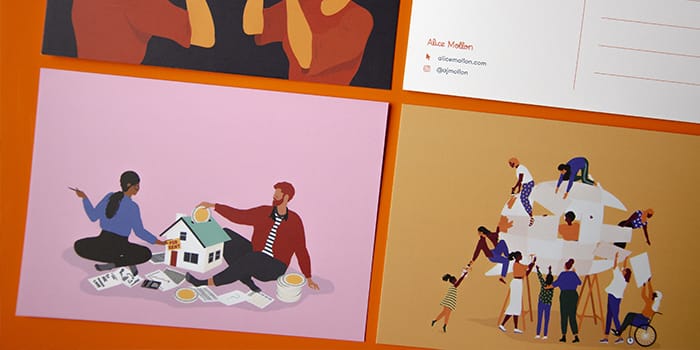
I also used my Instagram (and still do) as a sort of secondary, more “casual” portfolio, which helped me access an audience I wouldn’t have been able to reach on my own. A lot of the more prestigious publications that I’ve worked with actually found me there.
How do you choose illustration projects?
Thankfully, most projects that come my way are ones that I’d really like to take on. If I refuse a job, it’s generally because I already have too much on. Occasionally, it might be because the budget is unjustifiably small and the client is neither willing to negotiate, nor flexible with what they want for that price. That being said, there’s been a few occasions when I’ve just had a bad feeling about a project or a client, and said no for that reason.
Although I love seeing where illustration can take me, I particularly love editorial commissions. There’s such a breadth of topics to tackle, it never gets boring! Editorial art directors also (in my experience) tend to be the most open to taking creative risks.
Which illustration project are you most proud of to date?
It’s very very hard to pick one! Top of the list would be my first commission for The New York Times, which included a frame-by-frame animated header; a piece I did for Vogue about the rise in people renting their wardrobes online, which was recently longlisted for the World Illustration Awards; and finally, a piece on the race to find a Coronavirus vaccine, for The Economist.
More recently, I’m really excited to have collaborated with DrawFor – a nonprofit that partners with artists to raise funds for current issues, through sales of exclusive prints. They launched earlier this year with DrawForNHS and DrawFor Equality, raising money for NHS Charities Together and Stand Up To Racism. For this latest campaign, DrawForYoungLives, they’ll be donating profits to PAPYRUS, who are dedicated to the prevention of your suicide. It’s rewarding to know that something I’ve created can have a direct positive impact on the world.
You use a lot of metaphors and symbolism in your work. How do you approach visual storytelling?
I always start with words rather than pictures, scribbling down any key words or themes that stick out to me and progressively adding more related words and themes. Even topics that seem completely abstract can eventually be broken down into, or linked to more tangible entities.
Based on these lists and “mind maps”, I start to pull together wider visual concepts, which I turn into quick thumbnail drafts. At this point I can quickly see which concepts aren’t going to work, and which ones I should take forward to more developed sketches, until I get to the final artwork.
How do you use MOO for your brand?
One of the first things I did when I started freelancing was design some business cards. I created a whole bunch of tiny illustrations of me using different pens and tools, and used Printfinity to print a different one on the back of each card. They’re a really good example of the joy and playfulness that is integral to my work. Every so often, I also create postcards with some of my most recent pieces of work, which I then send to art directors and clients I’d like to work with.
Two years ago, I started creating holiday cards I send out to people I’ve worked with over the year to say thank you, but also to people I’d like to work with the following year. I used gold foil in the last ones and I was so happy with the extra touch of sparkle!
Have you ever used MOO products in any different or unusual ways?
Back at my first job, we ran a one-week course in partnership with The Prince’s Trust, teaching young people about app development. Over the course of the week, the participants would come up with an idea for an app and create a basic prototype of it. In order to help them come up with ideas, I created a little card game with prompts, using Printfinity and the rounded business cards. I’d actually love to do something like that again…!
What three key pieces of advice would you give to graduates hoping to become freelance illustrators?
- Know your worth. Just because you love what you do, does not make it any less valuable to the client.
- Build a network of “colleagues”, whether virtually or in real life who you can reach out to if you ever come up against work specific issues – these can include trade associations (like the AOI) and industry advocates, as well as peers.
- Finally, don’t be afraid to ask for more! More money, more time, more flexibility, more work. Whatever you need to really flourish. If you don’t ask, you won’t get!
Share your illustration portfolio in a creative way with business cards and postcards.
All kinds of businesses have had to turn into work from home companies over the last few months. For many, that’s meant a learning curve, with new habits, tools and practices to get to grips with. If you’re new to remote working or just want to brush up your know-how, these video conferencing tips should help you get the most out of your next virtual meeting.
-
Dress like you’re at the office
Remote work can be a more relaxing experience than going into the office, and nobody will judge you for lingering longer than usual in your pyjamas. But when you’re face to face with colleagues in a virtual meeting, you should present yourself professionally. That means being dressed in office-appropriate clothes with your usual grooming standards met.
And while everyone’s heard urban legends of the remote worker dressing in a shirt and tie with pyjama bottoms, this move is hard to recommend – unless you’re 100% sure you won’t accidentally shift position or stand up before the conf call is over.
-
Plan what you want to cover in advance
If you were meeting at the office, it would be easy to stroll over to someone’s desk after a meeting and pick up on something you’d forgotten all about, or grab a couple of workmates for a follow-up chat.
You don’t have that luxury with a work from home conference call though. Instead, make the most of all the time you have by planning what you want to cover ahead of the virtual meeting, making notes of your goals and talking points (might we suggest using a dedicated notebook for this purpose?).
-
Know your software
If you’re new to remote working, you may not have used tools like Zoom, BlueJeans, Google Hangouts or WebEx for professional calls.
Knowledge is power, so once you know what platform you’ll be using, download any software you need and spend a few minutes exploring the tools and features in advance of your first scheduled conference call.
Almost all video conferencing platforms share the same basic features:
- Screen-sharing, where everyone on the call can see what’s on your screen. (Tip: Close leisure-related browser tabs and mute any social notifications before jumping in)
- Mute, handy for sparing your colleagues from loud typing.
- Chat. You can use this to send URLs or as a back-up in case your audio cuts out.
- Record, which can be a handy alternative to taking notes – but make sure everyone on the call knows it’s being used.
-
Avoid accidental oversharing
When you work from home, your computer screen becomes a window into your life, and it can reveal things your work colleagues wouldn’t normally have access to. Your washing hanging up to dry, your half-dressed partner brushing their teeth in the background, your living room – none of these are anyone’s business but yours.
Before your conf call, stake out an area in your home where you have a neutral background and can sit undisturbed for the length of your work from home conference call. A blank wall is ideal, but avoid sitting in front of a window or other natural light source or you will appear in silhouette.
-
Take turns
With a virtual meeting, there are none of the usual cues to help with conversational turn-taking such as eye contact or hand gestures. This means you need to take care to let everyone have their say.
This is especially true if some people are in the meeting room while others are joining remotely – there’s a chance the virtual attendees will be given less attention.
If someone interrupts or you hear another voice chip in while you’re speaking, be sure to acknowledge them and allow them time to talk after you’re done. And if you have something to say, speak up confidently and make sure your voice is heard during the video call.
Ready to apply these video conferencing tips? Pimp your home office and ace your next virtual meetings with our Wow from home range.
British Nigerian multidisciplinary artist Stacey Olika uses art to promote social change. We met Stacey to talk about her journey as a young Black artist, the genesis of her creative business, AmakaDesigns, and her artistic crusade to encourage more representation in the art world – and beyond.
Tell us about yourself and your background as a multidisciplinary designer.
I grew up in Switzerland, and relocated to the UK when I was 8. Growing up and moving around, I was always surrounded by new and existing cultures. I did pretty well in school but academic subjects felt like a chore. When it came to anything creative, however, no one had to tell me twice. I thought it might be worth turning this passion into a career and I went and studied graphic design at university. I had no idea how my creative journey would have looked like at that point… and that was 3 years ago!
I thought design would remain my main focus, but once I graduated and stepped into the real world, my interests started to wander into speaking and curatorial work. I was intrigued by digital storytelling and very interested in topics such as the history of colonisation. I started working in these fields almost by accident and realised being “multidisciplinary” was all about collaboration, being curious and adaptive, combining methods and creating new ones.
I’m now a digital designer, curator and creative producer, the founder of AmakaDesigns – a freelance multidisciplinary business, co-founder of No Boundaries, and I currently work at the BBC as a production management assistant. I’m also a radio presenter on the side.
Why did you choose to dive straight into freelance work with AMAKA designs after university?
To be honest, diving straight into freelance work wasn’t really a choice I had set out for myself. 5 months before I graduated, I started to do freelance work for friends and the community, which progressively grew into a business. I was fortunate enough for my university final piece, I Am Melanin, to be noticed. I was given a space and took on the role as curator, artist, creative director and project manager to produce an exhibition. I guess that was my first taste of freelance after university, and it was by chance. I think that was the foundation of AmakaDesigns, because I used that project as a way to showcase what I can do as a business and brand.
How do you use MOO for your freelancing business?
I used MOO for my business cards, for which I got the most amazing responses. It took me a while to find the right vendor to trust for quality business cards. When I found MOO, I was hooked! From the range of sizes to the variety of finishes, it brought back the nostalgia of producing publications, posters and zines at uni.
What challenges have you faced in your career as a young Black creative?
I stepped into the creative world very much taking control of what I was producing, like my exhibition. I think this was a shock because we don’t often see Black people represented in this narrative, and especially young Black creatives. We are incredibly marginalised and misrepresented in society, so I think stepping out into the scene and taking charge so quickly was very unexpected.
That comes with a lot of internal doubt – as well as external. I felt like (and at times still feel like) I have to prove myself in a lot of spaces, and I can still see faces glaze over me too often. My creative career has only been 3 years, so I know I haven’t experienced the whole lot but so far, I have seen a lot of tokenism especially towards young Black creatives.
How did your journey lead you to a role at the BBC?
Since my first exhibition, I started taking more curatorial roles with art galleries across the city. With that, I started to gain the confidence to curate more events and projects by myself, including one project in particular where I hosted, planned and directed an event for creatives in Bristol. I initially had no idea how to make it happen. I just wanted to make it happen. I started brainstorming with my friends and talking about it and the BBC heard about it and took an interest in the project. They kept in touch after that. I think they noticed all the work I was doing and the fact that I was passionate about it. When the time was right, I was scouted and offered a role.
You’re also the co-founder of No Boundaries. How did the project start?
For a long time, myself and my co-founder Vanessa Wilson would often find ourselves travelling to London on 4am coaches to go to events, network and make connections. We ended up being so rundown, it started to feel like a chore.
We felt like this happened because not many lights were shone on cities like Bristol. We had to make people know who we were. That’s how No Boundaries was born. No Boundaries is all about showcasing various creatives and creating content collaboratively. Talent has no boundaries. It’s not restricted to the mainstream creative cities. We knew what the experience of living on the outside was like and we wanted those who felt like that to be included. In a sense, No Boundaries is bigger than a platform, because it doesn’t stop at just showcasing creatives, but we also work on creating content across disciplines.
How do you use your art to support social issues and promote diversity in art?
My art is a reflection of my inner thoughts, inspirations, and what I wish to see. My subjects are very intentional because I want them to reflect a new narrative. A narrative of the voices you get to hear and the faces you get to see that society too often underrepresents and misrepresents. I place people that look like me and reflect my culture in the foreground rather than the background.
What’s your vision for the future of AMAKA designs?
That is a good question! I’d like AmakaDesigns to become its own empire. I am all about owning my narrative and making it a space of inclusivity and authenticity, a pioneer in terms of creativity and self expression. Right now, I’m educating myself a lot on the business side of things so I can develop my brand and business on strong foundations.
Any advice for young creatives trying to get themselves noticed right now?
Sounds very cliché, but believe in yourself even if others don’t because that is what will push you and take you forward. When I had ideas and no idea how to execute them, I didn’t let that stop me. I watched YouTube videos, I spoke to people and shared my passion. There is a lot of power sharing your vision with likeminded people. Collaboration can get you through doors you never expected to walk into.
If there is something you want to change and make better, then do it. Don’t let the societal view of hierarchy knock you down from making a change.
Express your creativity (and get your business noticed) with MOO business cards.
Get inspiration from 5 businesses who are making their mark with custom notebook designs.
Whether you want to add your brand colors, logo, or photo, MOO’s Custom Notebooks will take your brand to the next level. But don’t take it from us—here are a few of our customers who have made some noteworthy branded notebooks.
1) Red Bull: a branded welcome
Red Bull—the globally recognized energy drink company— acknowledges the importance of brand-building across its business and marketing. And that goes for their employees as well.
“All new employees get a four-day onboarding experience at our HQ, where they get acquainted with the brand” Red Bull’s brand team explains. “We needed a branded notebook for these sessions that perfectly matched our branding.”
The resulting Notebook fits in perfectly with Red Bull’s other brand materials. And the Red Bull employees can’t seem to get enough: “Everyone wants one—I have to keep some of them hidden in my office!”
2) Berkshire Hathaway: sparking connections
Berkshire Hathaway HomeServices (BHHS, for short) is a real estate brokerage network with branches across the United States. In a crowded industry, BHHS made a name for itself by offering unique experiences for homebuyers and agents alike.
Relationships are the key to success in the real estate business, and every relationship begins with a simple first meeting. A great personal interaction opens the door, and the right leave-behind can seal the moment. While BHHS invest in technology, they still recognize the importance of personal connections.
Drysdale Properties supports and empowers their team through the MOO Business Services platform. Each of the 41 offices has their own account. Through it, BHHS agents can order and customize materials as needed. From Luxe Notecards to send thank you notes to clients, right the way through to Stickers and Custom Notebooks designs, branded materials are always within easy reach.
3) The Dots: less is more
The Dots is an online community of diverse creators and entrepreneurs throughout the UK. The company seeks to connect, support and champion people, as well as provide workshops and lectures to aspiring business owners and creatives.
Recently, The Dots teamed up with MOO’s creative team to create a limited edition Custom Notebook design. “We wanted to keep the notebook as subtle as possible” MOO’s Senior Designer, Steve Turner explains. “We went for a monochromatic notebook design, featuring silver foil on grey cloth which allowed the green seam of the notebook to shine.”
“We wanted to make sure the notebook’s features were centric to the design with the co-branding acting as the icing on the Notebook cake” Steve continued. “The outcome is a simple one, but aesthetically there were a number of considerations we had to make to ensure we got the design just right.”
4) Carolyn Suzuki: the power of illustration
From feel-good greeting cards to playful enamel pins, Carolyn Suzuki’s illustrations are brimming with color and life-affirming messages. The LA-based artist runs an online shop offering prints, cards and other products that showcase her bright personality and branding.
More recently, Carolyn designed and printed a Custom Notebook featuring her illustrations on the front and back to give out as a promotional giveaway to clients. “The Notebooks have been an added bonus” Carolyn says, “everyone comments on the quality of the bind and the beautiful printing!”. Now that’s a cool notebook design, if ever there was one!
5) MOO (that’s us!): celebrating customer service week
Customer Service Week is an international celebration of all things customer service. Throughout the world, customer-oriented companies recognize the importance of customer service and the ways it can shape a customer’s experience with your business. Each CS week, MOO’s Director of Customer Service, Doreen Berard, comes up with new ways to celebrate our amazing customer service team.
This year, we went for a bespoke notebook design! At the start of the week, each customer service agent received a ‘90s-themed Custom Notebook. “The senior agents thought it would be fun to relive their youth—as many of them had grown up in the ‘90s” Doreen explains.
“In past years during Customer Service Week, we have had carnival, superhero, movie and international themes. CS Week is generally planned a few months in advance and every year we have tried to up our game. We think the Custom Notebooks do just that.”
Had your fill of notebook inspiration?
Ready to create your first notebook cover design – and more? We have a dedicated team of MOO designers ready to take your artwork and add it from cover to cover. Get in touch with our friendly Account Managers to get started.
Discover our range of Notebooks & Journals here.
Don’t know your PPC from your SEO? Discover our guide to online advertising for small businesses.
Online advertising is a pretty sophisticated business these days, and if you’re a new startup you might be feeling overwhelmed by all the varieties of ads available. From PPC to social media ads, here’s a run-down of some common types of online advertising for small businesses, what they can do for you, and how to get started using them.
Display ads
What are display ads?
Online advertising in its simplest form. Also known as banner ads, they can appear in various places, such as along the side (skyscraper ads), across the top (leaderboards) or tucked into small spaces within a page (button ads).
How display ads work
Visitors to the website hosting your ad will see the graphic ad displayed, and will be able to click through to a landing page of your choice.
Are display ads for you?
Some marketers feel that display ads are less effective because they’re not as targeted as other types, and can be overlooked by website visitors who are used to ignoring them (aka banner blindness). However, they’re transparent, easy to understand and allow you to set a budget and stick to it, which makes them a great way to advertise your small business online.
How to get started
You can choose where to advertise based on your product type, location and target audience. Many websites sell ad space through a network, such as Google Ads. You can also work directly with websites you’ve chosen – this will tend to be cheaper, but it’s more work, too.
PPC
What is PPC?
PPC stands for Pay Per Click, and it’s a form of advertising linked to search engines and SEO. PPC ads appear on search results pages, usually at the top or on the right-hand side.
How PPC works
As the name suggests, you pay a small fee every time your ad is clicked on. With each clickthrough, an agreed amount is collected from a prepaid budget. When your budget is used up, the ad disappears.
Is PPC for you?
PPC involves a bit of strategic thinking – you need to target the search terms according to your audience, so it’s not as simple as just purchasing ad space. The advantage of PPC for small businesses is that it works with a set, prepaid budget and is very low-maintenance. If you have some time to learn the ropes, or have an SEO-savvy person on hand to help, it could suit you.
How to get started
Search engines like Google or Bing auction off the top spots on search results pages for keywords and phrases, such as ‘discount outlets new york’ or ‘handmade homewares’. To get started with PPC for your small business, you just need an email address to set up your account on their sites and start bidding for the searches you want.
Retargeting
What is retargeting?
Retargeting is a bit of a twist on the traditional display ad. Your ads are shown to people who have already visited your website, with the aim of tempting them back to make a purchase.
If you’ve ever left a website and then been ‘followed’ by the items you were looking at on other sites and social networks, you’ve already met retargeting in action. Done right, it’s more of a friendly reminder than a stalking experience.
How retargeting works
Retargeting is done through display ad networks, companies that buy ad space on a wide range of websites and social sites. The network provides small bits of code which your website leaves on a visitor’s device when they visit. These tagged visitors will then see your ads elsewhere. The network can place your ads on suitable sites and social networks, depending on your goals.
Is retargeting for you?
If you know you’re getting website visitors but you’d like your conversion levels to be higher, retargeting could be worth exploring as a good opportunity to advertise your small business online.
How to get started
Pick an advertising network and let them do the technical work for you! Some popular platforms include AdRoll, Perfect Audience and of course Google. Some networks have a minimum website traffic threshold, so they might not be suitable for smaller businesses.
Social media advertising
What is social media advertising?
Social networks have two key ingredients for advertising success – an audience they know well, and lots of visitors. Facebook, LinkedIn and Instagram are all popular choices, each with a well-known and firmly established user base. Promoted (paid-for) posts on Twitter or Pinterest are also available. These are highly visible to targeted users.
How social media advertising works
You can ask for your ad to be targeted to specific groups of people, such as under 25s or those living in a certain region. With some networks, these groups can be really specific so you can home in on your target audience for more chance of success. Different social platforms have their own ad formats, such as Facebook’s carousel and in-feed ads, or Instagram’s sponsored stories. The variety of formats makes social advertising a great opportunity for small businesses of all kinds.
Is social media advertising for you ?
Social advertising is a great way to build awareness of your brand. Because people spend a lot of time on social media, they’ll be repeatedly exposed to your ads, building recognition and familiarity. However, it does require a bit of effort to keep your ad content fresh and to monitor your campaigns.
How to get started
Social media advertising for small businesses is super accessible. Happily, it’s really simple to open an ad account on the platform of your choice, without needing to research third-party agencies or providers. Just hop onto their website, search for ‘ads’ and away you go!
Looking for more ways to get your business noticed? Take a look at our latest (and greatest) Postcards and Flyers.





